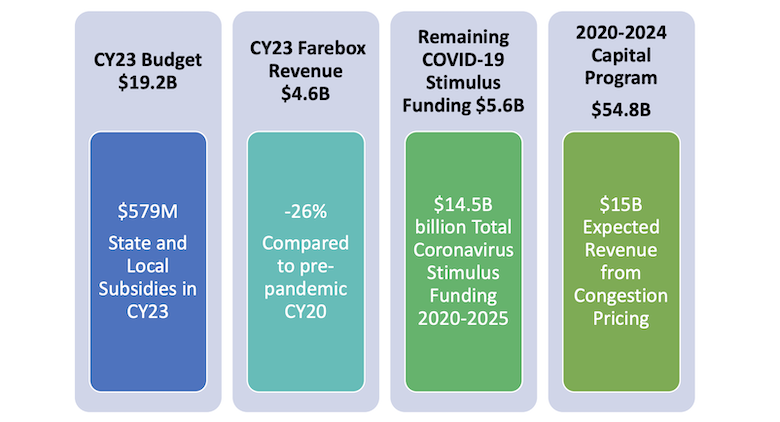NYC Congestion Pricing Plan: Down But Not Out


Congestion pricing was being counted on for a huge part of the New York MTA budget, as shown in this snapshot of revenue used by the New York City Council transportation committee in March 2023.
Chart: New York City Council
New York Gov. Kathy Hochul’s surprise June 5 announcement that she had indefinitely postponed the launch of a congestion pricing plan for midtown and downtown Manhattan—one month before the $15-per-vehicle toll was set to start—has raised concern for the future of New York City transit infrastructure. New Yorkers were counting on the added revenue to support $15 billion of improvements to the aging subway system while cutting gridlock and clearing the air.
Congestion pricing would solve the problem of how to fund the upgrades, which includes the Second Avenue subway extension to East Harlem, elevators to bring the system closer to compliance with federal accessibility laws, signal and power system modernization and hundreds of new buses.
The tolls, to be sure, are an imperfect solution—imposing costs that elected officials outside Manhattan estimate at $3,600 to $5,000 per year for a typical auto commuter from the suburbs or surrounding boroughs. Any new version of the plan that is advanced should contain carve-outs so the majority of the tax is paid by tourists and trucks, with discounts for people with lower incomes—and there should be no exemptions for government employees.
Gov. Hochul’s turnaround, only 14 months after she heartily and proudly endorsed the plan and praised the anticipated benefits, is transparently political. New York City-area moderate Democrats, with a few exceptions, are all now echoing her newfound worries about the burdens on commuters and the need to allow Manhattan business districts more time to bounce back from alarming office vacancy rates. Some of the concern is genuine, but the real worry is about alienating suburban voters in advance of the coming national election.
Ridership has rebounded since the pandemic, although not to pre-pandemic levels, when far more people used mass transit each day to reach Manhattan’s central business district—1.3 million—than the 143,000 who arrived by car. The Metropolitan Transportation Authority traffic mobility review board noted that revitalizing Manhattan depends on improved mass transit, not more automobile commuters.
Now is a good time to reconsider the state governor’s grip on MTA, an issue that became clear under Hochul’s predecessor Andrew Cuomo, who during his last term that ended in 2021 suddenly and impetuously decided that all agency engineers and contractors should cut their prices—including on contracts already underway. The governor appoints the MTA board chairman and vice chairman, four other board members plus those recommended by New York City’s mayor and surrounding county chief executives. Legislation to limit the governor’s role is long overdue.
As for transportation system improvements, companies set to do the work now have a much less clear idea of what financial resources they will have to design and build what’s needed, and how soon these will be allocated. But what is clear is that Gov. Hochul’s decision to postpone congestion pricing—and consequently the needed infrastructure improvements—will inevitably raise project costs.
The sooner the stalled plan is put into effect, the better.



